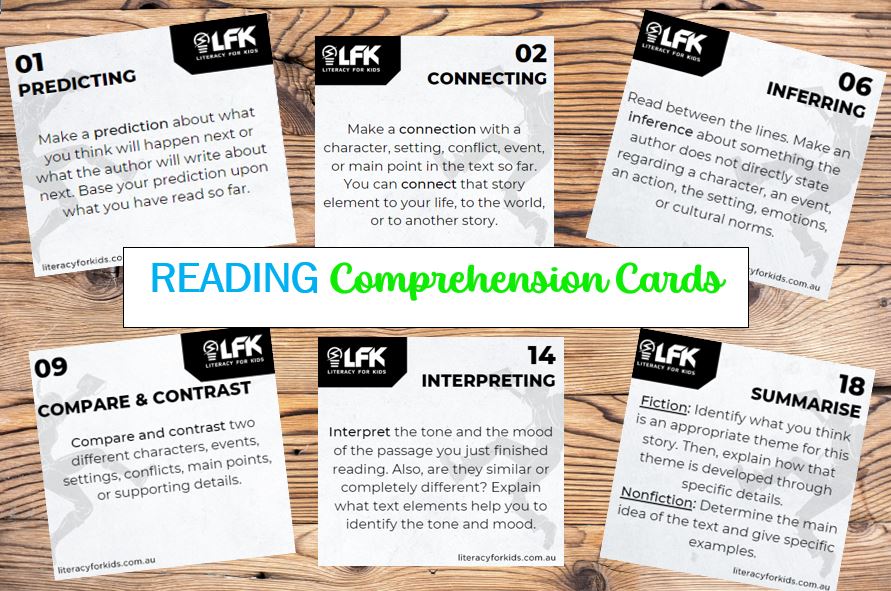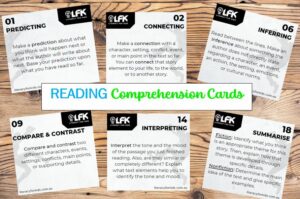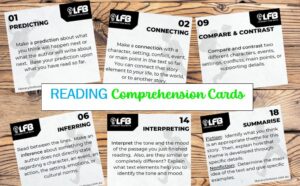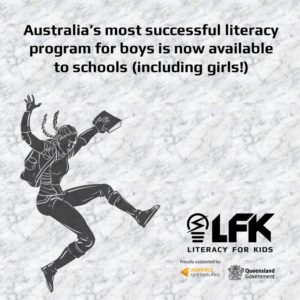Targeting Key Comprehension Skills

This post looks at the six strategies that are used most commonly in classrooms today. Direct instruction to support comprehension development includes what is referred to as the ‘super six’.
Elements |
Approach |
Example |
| 1. Making Connections – a process of shared thinking, includes sequencing, problem-solving, relating background knowledge | Teachers provide explicit instruction to teach students to draw on their prior knowledge, or schema, as a strategy to help them comprehend a text. |
Students are taught to:
|
| 2. Predicting and inferring – includes comparing and contrasting, drawing conclusions | Students are taught to draw on their prior knowledge to make inferences and draw conclusions. |
|
| 3. Questioning – includes self-questioning | Learners are taught to ask questions of the author, about the text and about their own predictions, questions and understanding of the text. |
|
| 4. Monitoring – sequencing, checking for understanding | Learners are taught to think about their own thinking: What do I understand? What am I unsure about? |
|
| 5. Visualising – includes forming mental images | Learners are taught to develop this skill when the teacher shares their own visual imagery or mental pictures invoked by the text. This is a great way to draw on personal experiences. |
|
| 6. Summarising – includes identifying key ideas, facts and relevant details | Students learn to identify the key ideas or information contained in the text. |
|
Comprehension skills build over time and can be developed when students are engaged in discussion, questioning, retelling or recalling, summarising and identifying key points and points of interest.
FREE for new home and school subscribers! Our Turn & Talk Comprehension Cards. Teach reading comprehension strategies in your classroom or at home

Student Comprehension Cards

LFB Comprehension Cards
Enquire today about our online programs that reflect sound educational thinking, current knowledge and research about best practice in reading acquisition. When used regularly, we deliver reading results.

Our programs ~ Literacy for Boys and Literacy for Kids ~ have had a huge uptake with schools and homeschoolers this year. It reflects two things:
a) the need for quality reading material that engages students
b) a decline in reading skills nationwide
We are incredibly passionate about improving kids’ literacy – research consistently supports the fact that confident readers achieve more highly than disengaged learners.
If we can get our children to enjoy reading they will grow into a reader, and that reader has more doors open to them in this world.
If you are wanting a resource that can boost your child’s or class’ literacy in 2024, please visit Literacy for Boys or Literacy for Kids
Check out our recent appearance on Channel 7 News ~
Parents ~ sign up for a free 30-day trial and improve your son’s literacy this year!
As an educator, do you want more from your literacy program? Contact us for a 30-day free trial in your school or classroom. Sign up for our newsletter and get FREE Comprehension Worksheets for Years 3 to 9.
Check out our blogs for more ideas and tips.
Using Technology to include all literacy learners
Steps to Successfully Support Disengaged Learners
See us featured in The Educator Australia magazine
Research confirms that early reading boosts literacy
Boys Love LFB – Here’s what they have to say!
Get boys reading in the digital age
Why write? Tips for reluctant writers
Brought to you by Tanya Grambower

